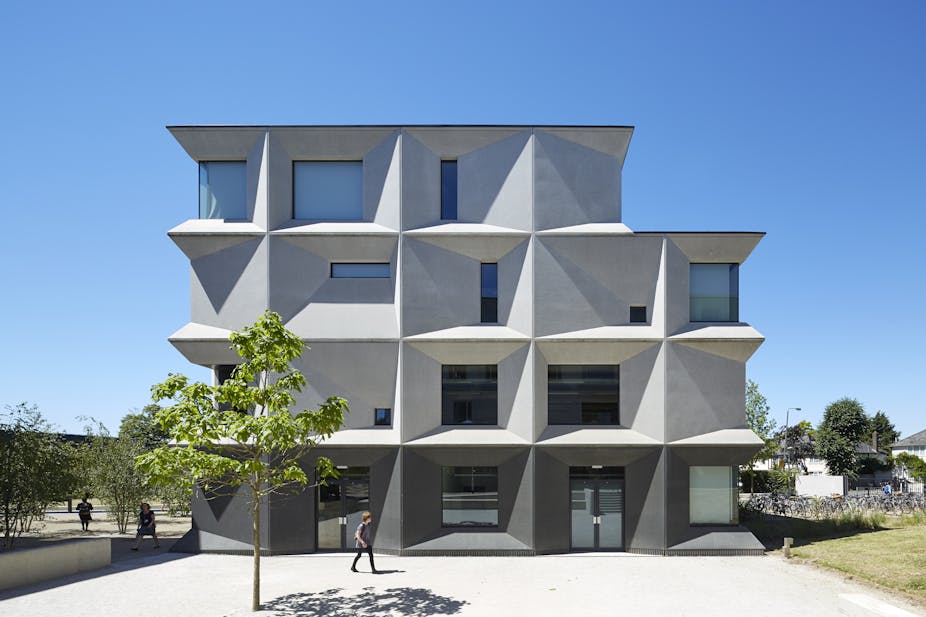Burntwood school in south London has won the Stirling Prize – the UK’s most prestigious architecture accolade. The success of Burntwood – which was remodelled at a cost of £40.9m between 2011 and 2014 – fuels the debate about the importance of architecture to learning.
The judging panel described the girls’ school in Wandsworth as the “most accomplished of the six shortlisted buildings”. They said the redevelopment of the school had displayed “the full range of the skills that architects can offer to society”.
The Stirling Prize is sponsored by the Royal Institution of British Architects and is presented to the architects of the building that has made the greatest contribution to the evolution of architecture in the past year.
“Burntwood sets a standard in school design that every child in Britain deserves,” the panel said.
As an architect, I would say that space in educational buildings certainly influences the activities that take place within them. We thrive in well-designed buildings and struggle in poorly designed ones (just imagine reading this with the roof leaking). But in what way does it impact or inspire educational practice?
For more than a century, school buildings in the UK were programme driven. Floor plans were largely determined by school boards or local authorities. Generic Victorian designs were often enhanced by imaginative architects (such as the Scotland Street School in Glasgow by Honeyman, Keppie and Mackintosh), but otherwise remained a simple configuration of large, well-lit and ventilated rooms and clear corridors and stairwells. Built in similar ways to the housing and places of worship of that same period, the result was a built environment with a visual cohesion that is lacking today.

This model proved remarkably resilient to subsequent educational systems. Even the Glasgow Steiner School housed itself happily for many years in that kind of classic Victorian school building. Such buildings may have been of their time in many ways, but they were loose enough to accommodate very different afterlives, serving very different clients within a different cultural context.
In the 1960s and 1970s, several pioneering primary schools in England designed by Maguire & Murray exploited agricultural steel portal frames to maximise the amount of flexible space, serving a new, progressive educational ethos. These buildings influenced a series of school buildings by Hampshire County Council, which exploited similar open spaces to establish a looser relationship between classrooms and corridors, blurring the distinction between what was a dedicated teaching space and what wasn’t.
The resulting architectural character appeared less prescriptive, suggesting education was something that could spill out of the classroom (symbolically and literally). Education was now open to interpretation, encouraging a different kind of engagement between pupil and teacher.
Quads and campuses
In higher education, the monastic ideal of “a place set apart” influenced the traditional space made up of courtyards, thresholds, cellular rooms for study or sleeping and large spaces for study, dining or worship. There may be a need to undergo annual technical upgrading (heating, lighting, wifi, etc), but as a model, this arrangement still can accommodate the central educational activities of concentration, teaching, research and administration successfully and often memorably.

In stark contrast to this, recent university buildings are designed very much like commercial office models with repetitive floors arranged around open-plan spaces and identical atria. Mobile digital platforms and e-learning has supposedly generated a need for “soft” spaces for student use as well as the traditional accommodation of laboratory, studio, lecture theatre and workshop.
Some of these buildings are carefully conceived within their environments, are finely detailed and constructed by accomplished architectural practices. But despite this, I find the result overwhelmingly corporate. While the traditional university had obvious associations with ecclesiastical models, contemporary higher education institutions have a new model in the world of business and commerce – “the real world” – the world of relevance and relativism.
Place and purpose
This may be a reassuring model for the university building committees responsible for them, but such buildings are neither distinguished nor inspiring. The presence of a distinct architectural idea is often absent in these otherwise professionally delivered projects.
But there are other possibilities – educational spaces designed for learning and imagination. I would place Glasgow School of Art’s Reid Building in this category (I cannot speak for Burntwood school or Greenwich University’s new architecture building, also shortlisted for the Stirling, as I have not visited them).

The Reid Building doesn’t follow the default flexibility model of the baggy building accommodating a disparate range of activities. Instead, its flexibility lies in its ability to offer a wide variety of differing spaces which invite diverse and imaginative uses. Those spaces have strong personalities (as do their users – this being an art school after all). This is a building which refuses to define what goes on inside and instead offers stages on which creative activities can be played out by subsequent generations (a characteristic also common to Mackintosh’s very different School of Art Building opposite).
A place which inspires and informs subsequent generations is a fundamental requirement of any institution which has the responsibility of “sheltering” those involved in formal education. The partnership between place and purpose is what makes such buildings inspirational. Architects and clients willing to create such buildings in the 21st century are urgently needed.

